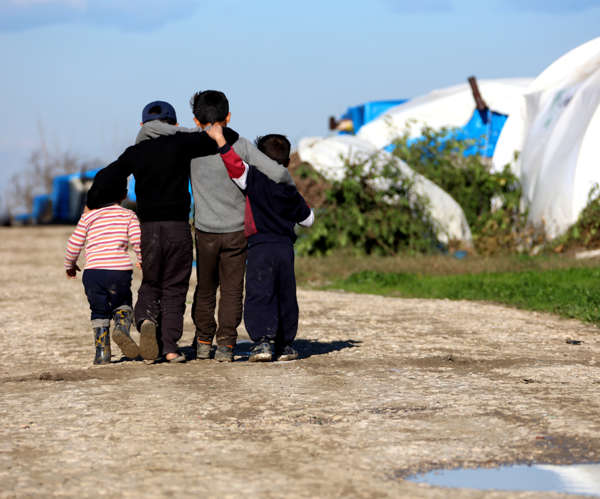Help refugees feel at home in the U.S.
Help refugees feel at home in the U.S.

108.4 million
We’re living through the worst refugee crisis in world history. Across the globe, 108.4 million people have been forcibly displaced worldwide. Of these, 40% are children.
Bethany believes every one of them deserves to be safe, loved, and connected.

“Welcome. You belong here.”
Every year, tens of thousands of refugees are resettled in the U.S., seeking safety and a chance at a new life. With your help, we surround refugees with welcome and support during one of the hardest times in their lives. Our goal is to help refugees become self-sufficient, thriving members of their new communities.
Top five countries of origin for refugees resettled through Bethany:
- Democratic Republic of the Congo
- Afghanistan
- Burma
- Syria
- Bhutan
Ways to welcome
Co-sponsor a refugee family
Co-sponsorship is a long-term commitment (at least six months) by a group of individuals—often as part of a church or other community organization. In partnership with their local Bethany branch, the co-sponsor group walks alongside a newly arrived refugee individual or family, providing support as they begin their new life. Sign up to learn more and get started.
Provide transportation
Transportation is one of the biggest needs for many refugees when they first arrive in the U.S. Refugees need help getting to medical appointments, government offices, grocery stores, their jobs, and more. Sign up if you’re interested in volunteering as a driver for refugees in your area.
Offer housing or employment
Are you a landlord or a business owner? Two immediate needs for newly arrived refugees are housing and employment. Connect with us if you can help provide refugees in your area with housing or a job.
Donate material goods or money
Refugees need a lot of help as they start their new lives. There’s a big gap between the stipend a refugee receives from the government and the cost of their actual needs. Connect with your local Bethany branch and learn the best way to help refugees in your area. This might mean donating furniture, common household items, grocery store gift cards, or a simple financial donation.
Find a resettlement program near you
Frequently asked questions
Who is a refugee?
The United Nations High Commissioner for Refugees (abbreviated UNHCR) defines a refugee as someone who is escaping from, or has a well-founded fear of, persecution in their home country because of their race, religion, nationality, political opinion, or inclusion in a certain social group. To be eligible for resettlement in another country (like the U.S.), a person must register as a refugee with UNHCR or at a foreign embassy.
The overwhelming majority of refugees are permanently displaced, meaning they will likely never be able to return to their original homes. Their only option is to find new homes.
What’s the difference between a refugee and an asylum-seeker?
These labels describe similar circumstances, but different pathways into the United States. In the context of the U.S. immigration system, a refugee is someone who has fled their home due to a well-founded fear of persecution or violence, and who has been referred to the U.S. by an organization like UNHCR. The status of “refugee” is typically given to someone before they enter the country.
An asylum-seeker is someone who crosses a border into the U.S. seeking safety from violence, poverty, or persecution but does not yet have a legal status. Asylum-seekers must apply for legal status once in the country, a process that can take years.
Are refugees dangerous?
Coming to the U.S. as a refugee is the most difficult way to legally enter the country. Refugees undergo a more thorough vetting process than any other traveler to the United States. According to UNHCR and the U.S. Department of Homeland Security, the vetting process includes screening by eight federal agencies and six different security databases, five separate background checks, four biometric security checks, three in-person interviews, two inter-agency security checks, as well as medical screenings.
A person with a history of violence or intent to do harm to the country is unlikely to try to come to the U.S. as a refugee, as they would be compromised in the vetting process.
How do I serve refugees if I don’t live near a Bethany refugee resettlement program?
Bethany is one of many organizations around the country serving refugees. If you don’t live near a Bethany resettlement program, use this interactive map from the Office of Refugee Resettlement to find a program near you.
You can also support refugees by giving a financial gift to Bethany. Resettlement agencies rely on the generosity of donors to sustain their programs and provide refugees with services needed to integrate and thrive in their new communities. By giving to resettlement programs, you’re embracing refugees and letting them know they’re welcome.
I’m a refugee or asylum-seeker. How do I get help?
If you’re a refugee or asylum-seeker who needs information or support, please visit this page to learn how we can serve you.
Other ways we serve refugees and immigrants
Long-term refugee and immigrant foster care
Refugee families are sometimes separated due to death, illness, or imprisonment. When family reunification is unlikely, or even impossible, the best option for children and adolescents is long-term care by a foster care family.
Short-term immigrant foster care
When unaccompanied migrant children seek asylum in the U.S. without their parents, they need short-term foster care until they can be reunified with their family. Short-term immigrant foster care is a powerful way to show love to a child who needs a temporary home.
Trafficking Victims Assistance Program
Bethany provides support to refugee and immigrant survivors of human trafficking and their families through our Trafficking Victims Assistance Program (TVAP). The program offers access to basic resources—at no cost—including food, clothing, housing, employment, and more.
Global refugee services
In Ethiopia, Colombia, and Romania, we provide holistic services for children and families fleeing violence, poverty, and persecution. We specialize in treating mental and emotional trauma experienced by refugees and migrants, helping them heal and thrive.
Read real stories of refugees and those who serve them
Read real stories of refugees and those who serve them
2 years after the Afghanistan withdrawal: How can I help?
Co-sponsors meet the needs of refugees and help them thrive within their new communities.
Landlord shares inspiration, benefits of renting to refugees
From Kenya to Kalamazoo, landlord shares her journey to renting exclusively to refugees.
Neighbors start refugee co-sponsorship group, welcome Afghan family
Refugee co-sponsorship provides support to newcomers and strengthens the community.
